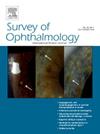Antiviral therapy for cytomegalovirus retinitis: A systematic review and meta-analysis
IF 5.9
2区 医学
Q1 OPHTHALMOLOGY
引用次数: 0
Abstract
Cytomegalovirus retinitis (CMVR) is a significant cause of blindness in patients with advanced acquired immunodeficiency syndrome (AIDS). There are no established guidelines for its treatment, resulting in varied antiviral approaches. We pooled data from 59 studies (4501 patients) to evaluate treatment variations and outcomes (CRD42022321088). Overall pooled estimates showed visual acuity improvement at 18 % (95 % CI: 7–41 %), inflammation resolution at 90 % (95 % CI: 81–95 %), retinal detachment at 11 % (95 % CI: 8–14 %), and recurrence at 19 % (95 % CI: 11–31 %). The main antiviral treatment approaches identified were: (1) intravenous antivirals alone in 33 studies, (2) intravitreal antivirals alone in 26 studies, (3) oral antivirals alone in 3 studies, and (4) a combination of systemic (oral or intravenous[IV]) and intravitreal antivirals in 7 studies, with varying schemes and durations. Ganciclovir was the predominant antiviral, with intravenous administration being the most reported (in 23 studies), followed by intravitreal administration (in 20 studies). While visual acuity improvement was comparable, inflammation resolution tended to be higher with intravitreal than with IV antivirals, though not statistically significant (88 %, 95 % CI: 69–96 % vs 75 %, 95 % CI: 35–94 %, p = 0.38). Retinitis progression rate for IV ganciclovir was lower than for those without ganciclovir. Inflammation recurrence was significantly lower in antiretroviral (ART)-treated compared to non-ART-treated HIV/AIDS patients (10 % (95 % CI: 4–20 %) vs 33 % (95 % CI: 19–50 %), p < 0.01). Neutropenia, particularly with ganciclovir, was the most reported adverse effect (up to 50 %).
巨细胞病毒视网膜炎的抗病毒治疗:系统回顾和荟萃分析。
巨细胞病毒视网膜炎(CMVR)是晚期获得性免疫缺陷综合征(AIDS)患者失明的一个重要原因。目前尚无既定的治疗指南,因此抗病毒治疗方法也多种多样。我们汇总了 59 项研究(4,501 名患者)的数据,对治疗方法的变化和结果进行了评估 (CRD42022321088)。总体汇总估计结果显示,视力改善率为 18% (95% CI: 7-41%),炎症消退率为 90% (95% CI: 81-95%),视网膜脱离率为 11% (95% CI: 8-14%),复发率为 19% (95% CI: 11-31%)。已确定的主要抗病毒治疗方法有(1) 33 项研究中仅采用静脉注射抗病毒药物,(2) 26 项研究中仅采用玻璃体内抗病毒药物,(3) 3 项研究中仅采用口服抗病毒药物,(4) 7 项研究中采用全身(口服或静脉注射)和玻璃体内抗病毒药物联合治疗,治疗方案和持续时间各不相同。更昔洛韦是最主要的抗病毒药物,静脉注射的报道最多(23 项研究),其次是玻璃体内注射(20 项研究)。虽然视力改善程度相当,但玻璃体内抗病毒药物的炎症消退率往往高于静脉注射抗病毒药物,但无统计学意义(88%,95% CI:69-96% vs 75%,95% CI:35-94%,P = 0.38)。静脉注射更昔洛韦的视网膜炎恶化率低于未注射更昔洛韦的患者。与未经抗逆转录病毒治疗的艾滋病毒/艾滋病患者相比,接受抗逆转录病毒治疗的患者炎症复发率明显较低(10% (95% CI: 4-20%) vs 33% (95% CI: 19-50%),p < 0.01)。中性粒细胞减少,尤其是更昔洛韦,是报告最多的不良反应(高达 50%)。
本文章由计算机程序翻译,如有差异,请以英文原文为准。
求助全文
约1分钟内获得全文
求助全文
来源期刊

Survey of ophthalmology
医学-眼科学
CiteScore
10.30
自引率
2.00%
发文量
138
审稿时长
14.8 weeks
期刊介绍:
Survey of Ophthalmology is a clinically oriented review journal designed to keep ophthalmologists up to date. Comprehensive major review articles, written by experts and stringently refereed, integrate the literature on subjects selected for their clinical importance. Survey also includes feature articles, section reviews, book reviews, and abstracts.
 求助内容:
求助内容: 应助结果提醒方式:
应助结果提醒方式:


